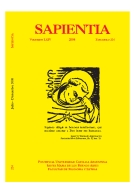Por favor, use este identificador para citar o enlazar este ítem:
https://repositorio.uca.edu.ar/handle/123456789/4243| Título: | Style and the “Idea” of the sophist after Plato : the impact of form typology on sophistic teaching and writing on interdisciplinary scholarly work | Autor: | Haase, Fee Alexandra | Palabras clave: | SOFISTAS; IDEA; Platón, 427-347 a.C. | Fecha de publicación: | 2008 | Editorial: | Pontificia Universidad Católica Argentina. Facultad de Filosofía y Letras | Cita: | Haase, F. A. Style and the “Idea” of the sophist after Plato : the impact of form typology on sophistic teaching and writing on interdisciplinary scholarly work [en línea]. Sapientia. 2008, 64 (224). Disponible en: https://repositorio.uca.edu.ar/handle/123456789/4243 | Resumen: | Resumen: Después de la primera sofística, los sofistas actuaron entre el resto de los pensadores del Mediterráneo como un grupo definido. Dado que hay muchos ejemplos que muestran que los sofistas ejercían sus prácticas y que también eran personas comprometidas en otras actividades, vamos a examinar aquí diversos casos de semejanzas y diferencias entre ellos y otros grupos de pensadores. Nuestras tres preguntas fundamentales son: qué, cómo y por qué los sofistas escribían y enseñaban. Intentaremos responder haciendo un análisis diacrónico de las principales formas y géneros de escritura que produjeron (qué). El cómo lo responderemos en su desenvolvimiento como una actividad comunicativa más allá de las fronteras de las disciplinas de la época. El por qué tendrá su respuesta al enfatizar la necesidad de la actividad de los sofistas en la socialización de la época y en la educación de la antigüedad. Al aseverar que el estilo era la idea de los sofistas, ponemos la noción de idea en Platón en el contexto de idea derivado de los sofistas contemporáneos a él y de los sofistas posteriores (segunda sofística) y centramos el foco en la función de visualidad expresada en su concepto de idea desde las obras sofísticas más tempranas en la época de Platón hasta las contribuciones posteriores. Abstract: After the First Sophistic sophists acted among the scholars in the Mediterranean in many regards as a distinct group. Since many examples show that they were not only performing sophists, but they were persons engaged in other activities, we will examine here several cases of similarities and differences between them and other groups of scholars. Our three basic questions ‘what, how and why did the sophists teach and write?’ We try to answer examining diachronically the major forms and genres of writings they produced (‘What’), the ‘How’ we answer looking at their sophistic performance as a communicative activity beyond borders of contemporary disciplines, and the ‘Why’ we try to answer emphasizing the necessity of sophistical activity in the contemporary socialization and education in antiquity. Claiming that style was the idea of the sophists, we put Plato’s concept of idea critically in the context of the concept of the idea derived from contemporary and later sophists of the Second Sophistic focusing on the function of visuality expressed in their concept of idea from early sophistic works in the time of Plato and later contributions. |
URI: | https://repositorio.uca.edu.ar/handle/123456789/4243 | ISSN: | 0036-4703 | Disciplina: | FILOSOFIA | Derechos: | Acceso Abierto | Fuente: | Versión original impresa en Sistema de Bibliotecas UCA: Sapientia Vol. LXIV Tomo XLVII, Nº 224, 2008. |
| Aparece en las colecciones: | SAP - 2008 Vol LXIV nro. 224 |
Ficheros en este ítem:
| Fichero | Descripción | Tamaño | Formato | |
|---|---|---|---|---|
| style-idea-sophist-after-plato.pdf | 209,51 kB | Adobe PDF |  Visualizar/Abrir |
Visualizaciones de página(s)
142
comprobado en 27-abr-2024
Descarga(s)
319
comprobado en 27-abr-2024
Google ScholarTM
Ver en Google Scholar
Este ítem está sujeto a una Licencia Creative Commons

